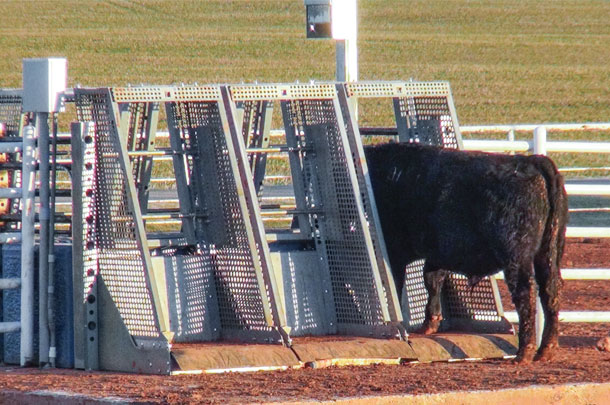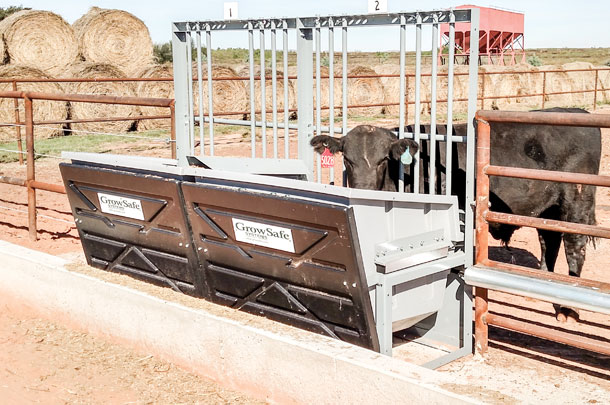Both systems allow for the real-time measurement of feed consumption through installed equipment in the pen or on the range. Data collected are uploaded through cloud-based solutions and provided back to the producer, either in a report or as raw data to calculate consumption, actual gains and residual feed intake.
The information creates another tool producers can use to evaluate each animal on its own merits of conversion in the selection of replacement stock with proven feed efficiency.
Equipment for any operation
The Canada-based GrowSafe Systems sells producers a minimum software and equipment package of eight nodes (bunks). The 24-hour data collection cycle generates about 4,000 data points per animal that GrowSafe will manage for an additional fee.
If a producer chooses to manage the data themselves, GrowSafe will provide the raw data. The cost for the system is around $100,000 with additional add-on nodes available in the $15,000 range.

For those producers wanting to manage their own data and looking for a portable, user-friendly solution, C-Lock of Rapid City, South Dakota, has created the SmartFeed option. The portable feedbunks can be positioned anywhere, providing the location is flat and receives enough direct sunlight to operate the optional solar panels; directly plugging the unit into a power source is also an option.
The single-unit bunks can be purchased individually for around $7,000 with each bunk accommodating seven animals per test. Data collected from each animal is uploaded to the cloud, with C-Lock providing reporting on individual animal intake.
Both systems allow only one animal to access feed at any given time and utilize ear-implanted electronic identification tags to distinguish between animals. The technology applied in both systems captures real-time bunk weights as an animal consumes the provided ration and is programmed to accommodate environmental factors that could skew the data, such as rain, snow and wind.
Finding value in data
For New Mexico rancher John Heckendorn, the decision to choose a technology-driven feeding program was one that made the most economic sense.
“Some of us from New Mexico were taking bulls all the way up to Montana to the Midland Bull Test to try to get some individual feed efficiency data,” says Heckendorn.
He says initially he and the group of cattlemen who would come to form the 18-cooperator Tucumcari Feed Efficiency Test LLC (TFET) didn’t believe they could afford to buy a GrowSafe system but, after visiting with local banks, they decided to finance a system for three years.

“Our initial cost was about $100,000. That was for eight bunks that allowed us to test 128 bulls,” Heckendorn says. “Over the three years, if you divide the number of bulls we were able to test by the investment, we have about $250 per bull invested in the GrowSafe feed efficiency testing.”
The added value the efficiency data has provided hasn’t been immediate, Heckendorn shares, but has helped to generate interest in the annual sale.
“We feel like more and more people are starting to see the value these feed-efficient animals bring to their herd, and we are definitely seeing more interest in our sale because of it,” he says.
Finding those efficiencies in the data provided by GrowSafe is a role New Mexico State University livestock specialist Marcy Ward has taken on in recent years. As director of the Tucumcari Bull Test and Sale, Ward manages the data GrowSafe provides, allowing producers to build reports for the sale catalog for each bull and make replacement female decisions with the results of the TFET’s subsequent heifer test.
Today, TFET sees Angus, Hereford, Charolais, Braunvieh, Red Angus and Limousin breeds cycle through their system, and Ward helps each producer submit data to their respective association. In its fourth year, the test has seen more than 500 animals pass through the system and currently has a waiting list of non-cooperator producers.
For Oklahoma-based Hutson Angus Farms, the pursuit of maximized feed efficiency has been a key component of the value the operation has found through the GrowSafe system.
“We have been testing bulls (using) GrowSafe for 10 years; for eight of those, we tested in Paxton, Nebraska, at the Profit Maker Bull Test,” says herd manager Joe Sanders. “We saw enough data and (selection) improvement that we invested in our own set-up.
Because feed efficiency is a very heritable trait, this test has really allowed us to weed out those animals that are inefficient before they ever go into production.”
Sanders says the data the GrowSafe system has provided have allowed for faster genetic advancements, not only testing the program’s bulls but also every replacement heifer for the herd; those genetic gains have made the system very cost-effective in the long run.
“Sometimes it’s surprising to get a new, high-powered bull and run him through the test to find out he isn’t going to do for us what we need in terms of feed efficiency,” he says. “We are seeing females stay in the herd longer and be more productive; they are breeding back sooner. Feed efficiency is key to all of that.”
Adapting for environments
For SmartFeed customer Rob Thomas, owner of Baker City, Oregon’s Thomas Angus Ranch, the decision to go with a portable, solar-charged option was a necessity.
“We are in an area that doesn’t have electricity, so we use solar panels. Those marry up with the hardware on the feedbunks to send data to the cloud we can access any time,” says Thomas.
The affordable system allows for the collection of high-quality data anywhere, any time, without any compromise of accuracy or quality of data.
“I was introduced to the company through extension and really liked the way the system could be set up and going in a matter of minutes. It is really simple to use,” he says. “If we decide to test bulls at a different location, we can do that pretty fast.”
As the need for additional bunks increases, the system can be added onto by purchasing an additional bunk or more, with all of the data accessible and owned by the producer.
For Thomas, the SmartFeed system has been a valuable tool in both the selection of bulls and donor cows in the operation’s ET program, as well.
“We use this efficiency test to select all of our donor cows. We are multiplying these genetics so many times, getting so many calves out of these bulls and females, this system really helps us narrow down which animals we want to bring back into our breeding system,” he says.
Thomas says their operation is also seeing the test identify some incredible genetics. “In our last group of bulls, one animal converted at 3.29 to 1 – he was really an outlier, gaining 6 pounds a day.”
Shortly before this article went to print, the bull was purchased for over $100,000, and Thomas credits much of that to the animal’s high conversion rate, identified through SmartFeed testing.
Here to stay
Whether ranching in the hills of Oregon, breeding bulls for commercial producers in the sparse grazing of New Mexico or operating a seedstock operation in Oklahoma, efficient animals mean more marketed beef with fewer inputs, and producer demand for the tool is evident as more companies come to the market with efficiency-finding solutions. The technology is here to stay.
Thomas chuckles, “The system, for us, is kind of like an iPhone – you don’t understand all of the technology but you sure like the way it works.” ![]()
PHOTO 1: Portable SmartFeed bunks, equipped with solar panels, allow Thomas Angus Ranch to relocate the equipment to any pen on their operation. Photo courtesy of Thomas Angus Ranch.
PHOTO 2: Each GrowSafe bunk allows only one animal at a time to access feed, reading and recording that animal’s unique ear-implanted electronic identification tag and grams of feed consumed. Photo courtesy of Hutson Angus Farms.
PHOTO 3: GrowSafe bunks at Tucumcari Feed Efficiency Test. Photo courtesy of Marcy Ward, Tucumcari Feed Efficiency Test.
Laura Handke is a freelance writer based in Kansas.







